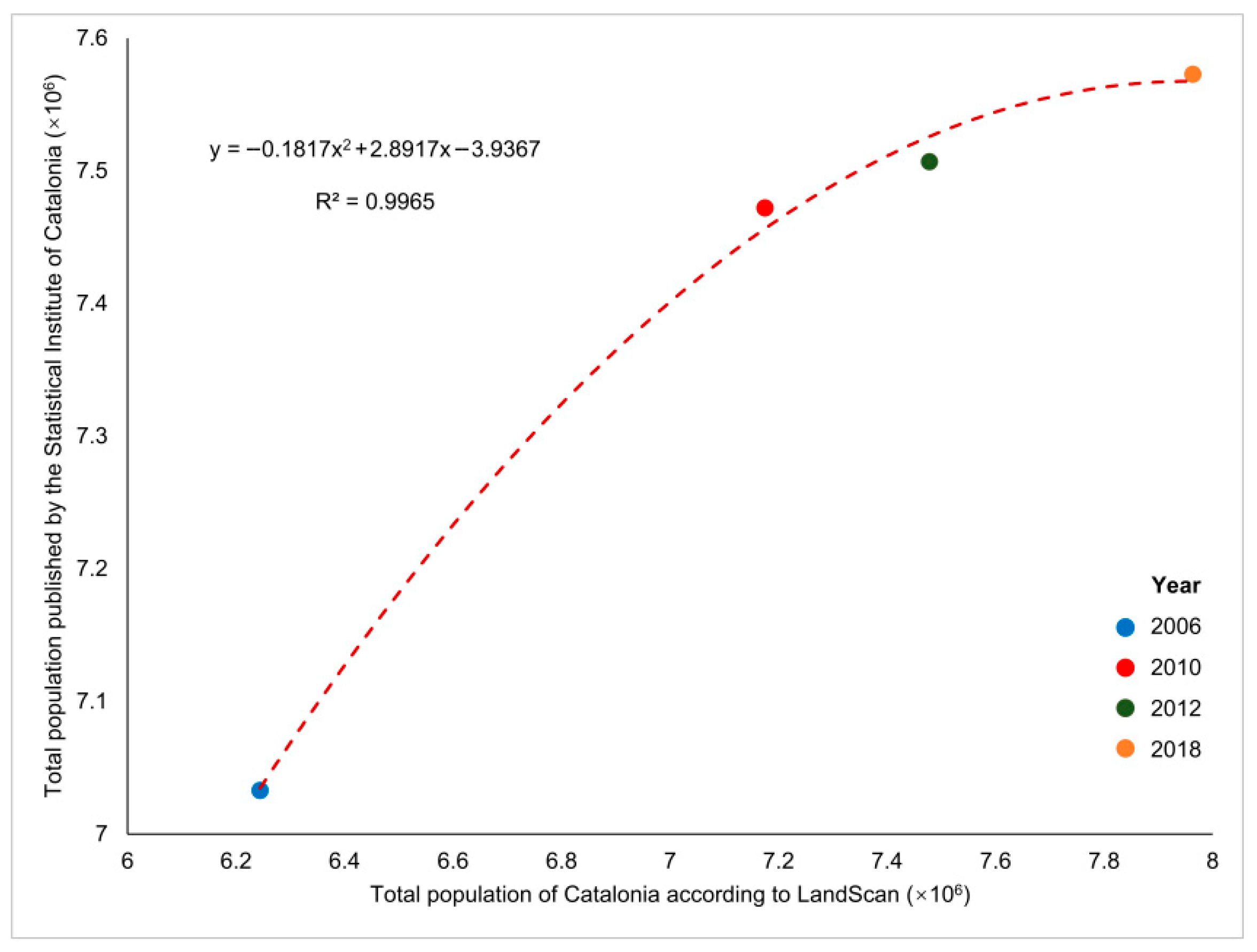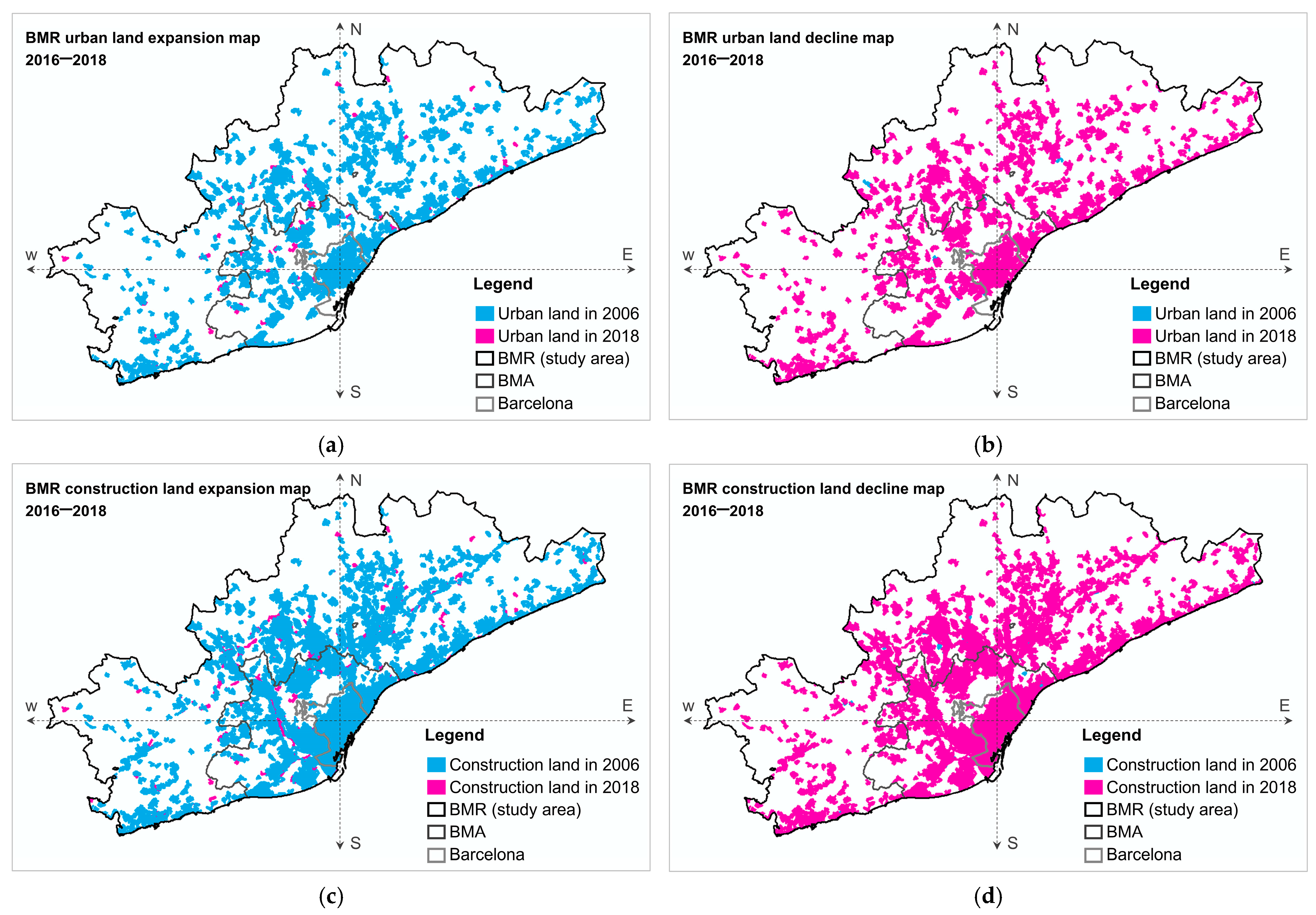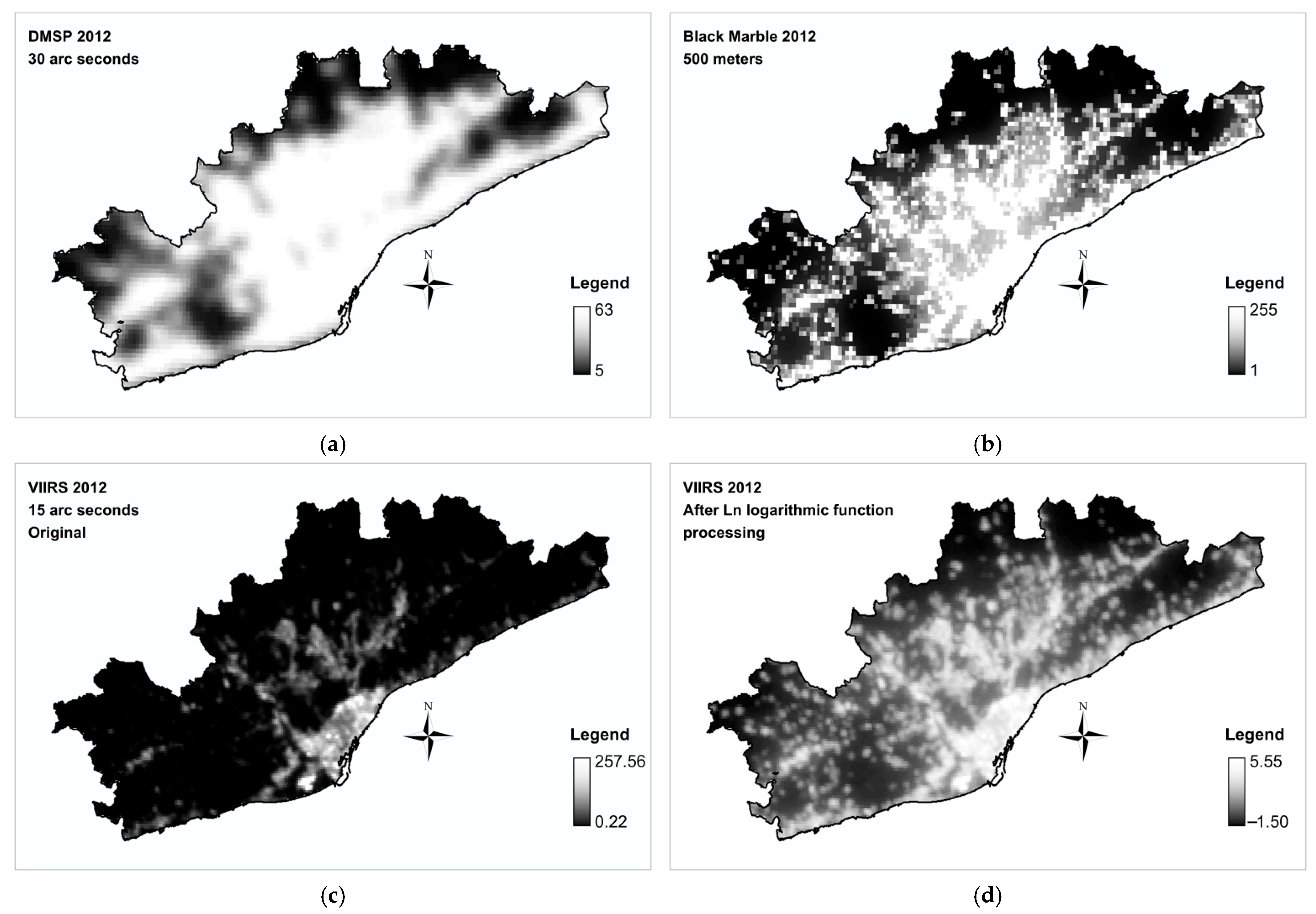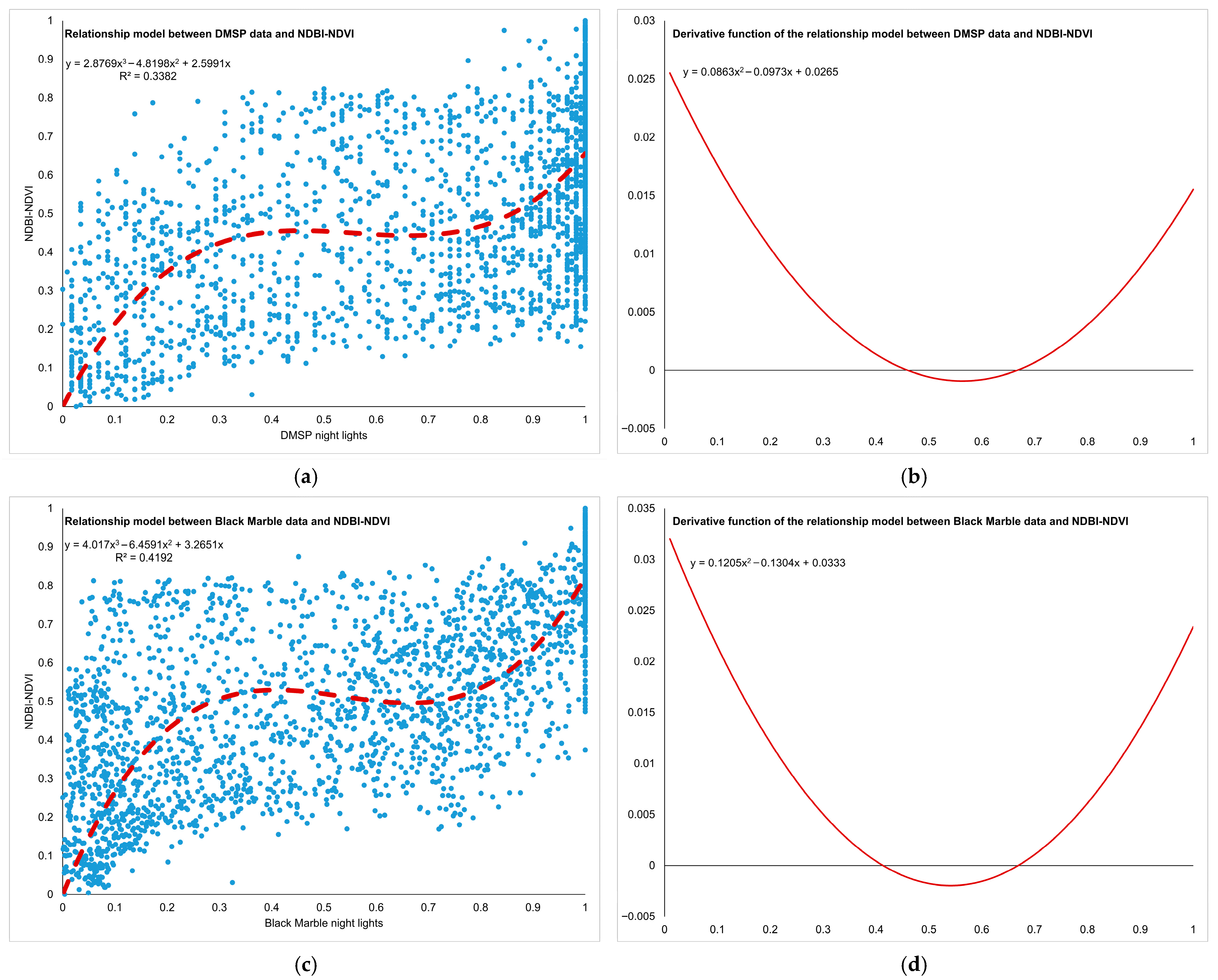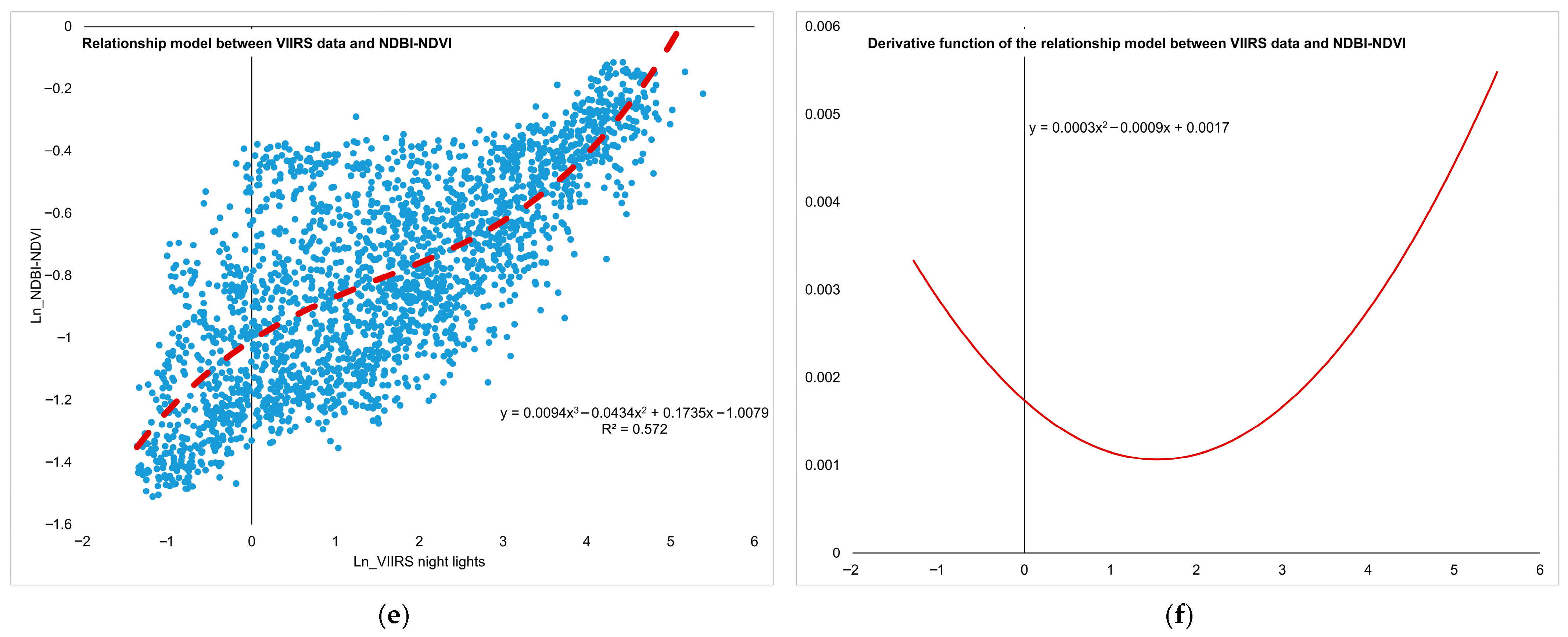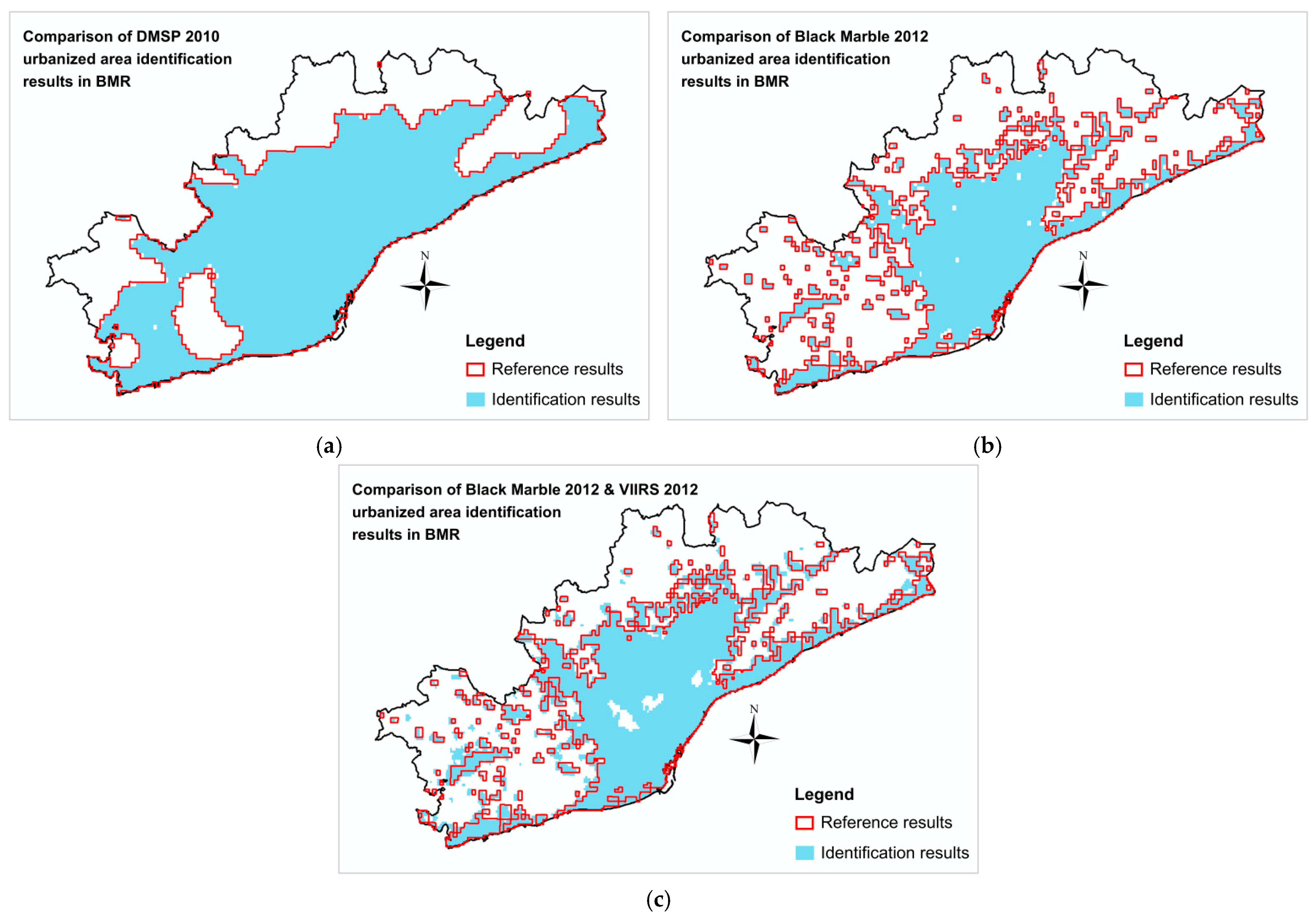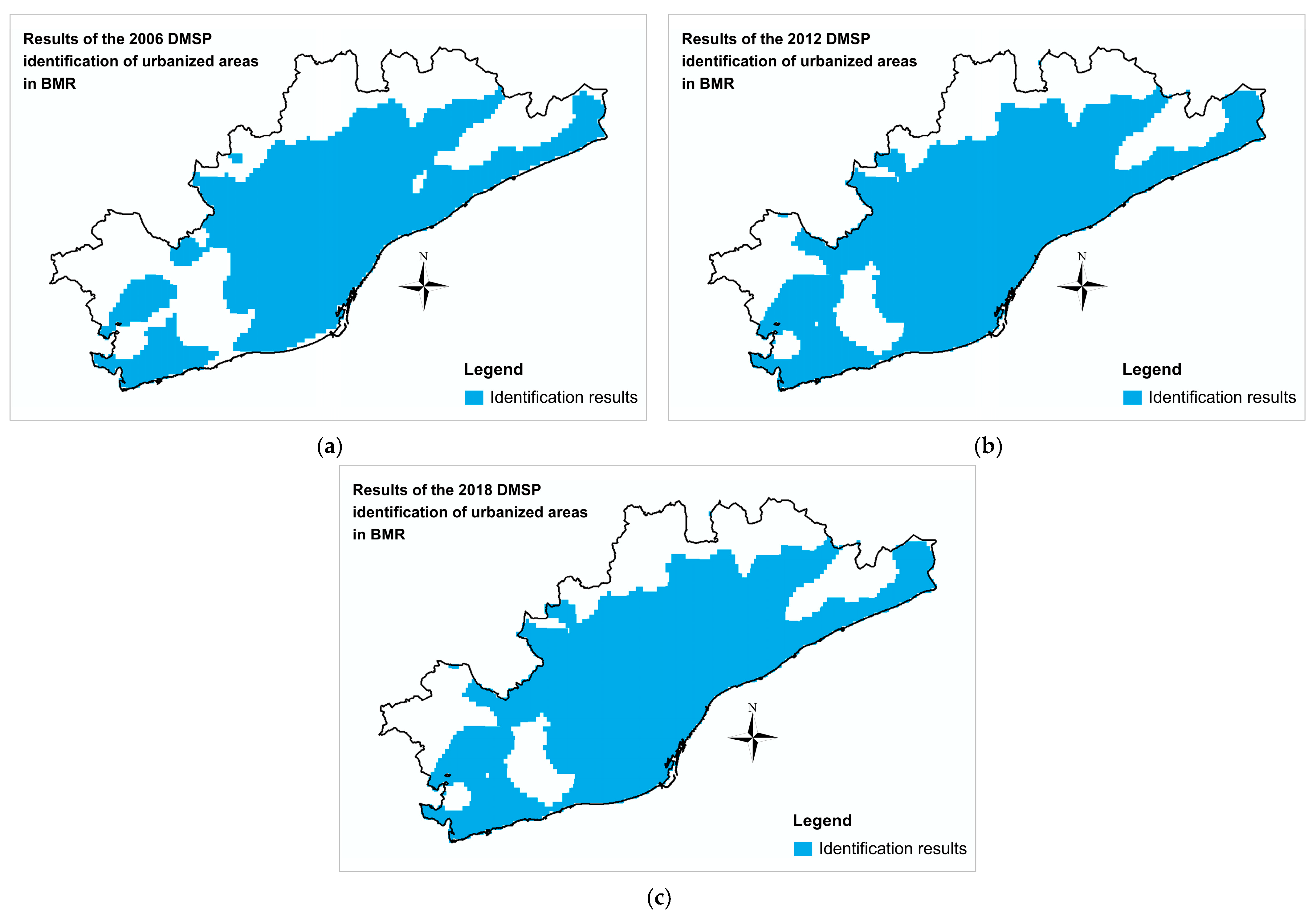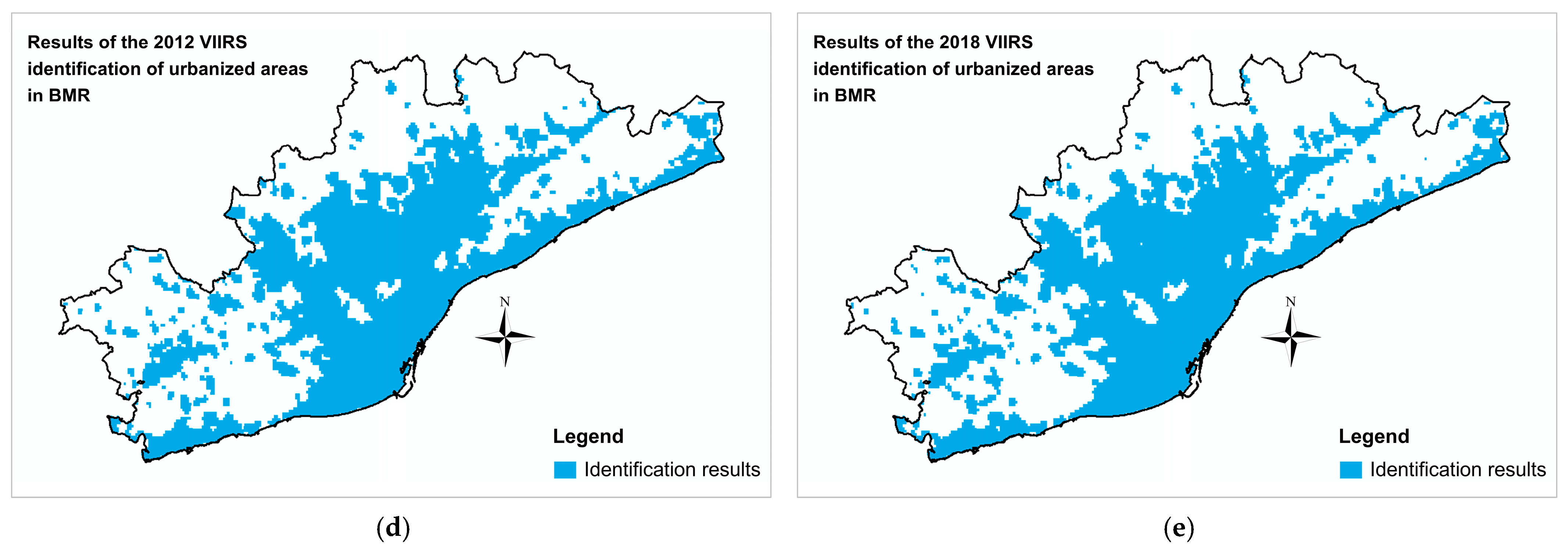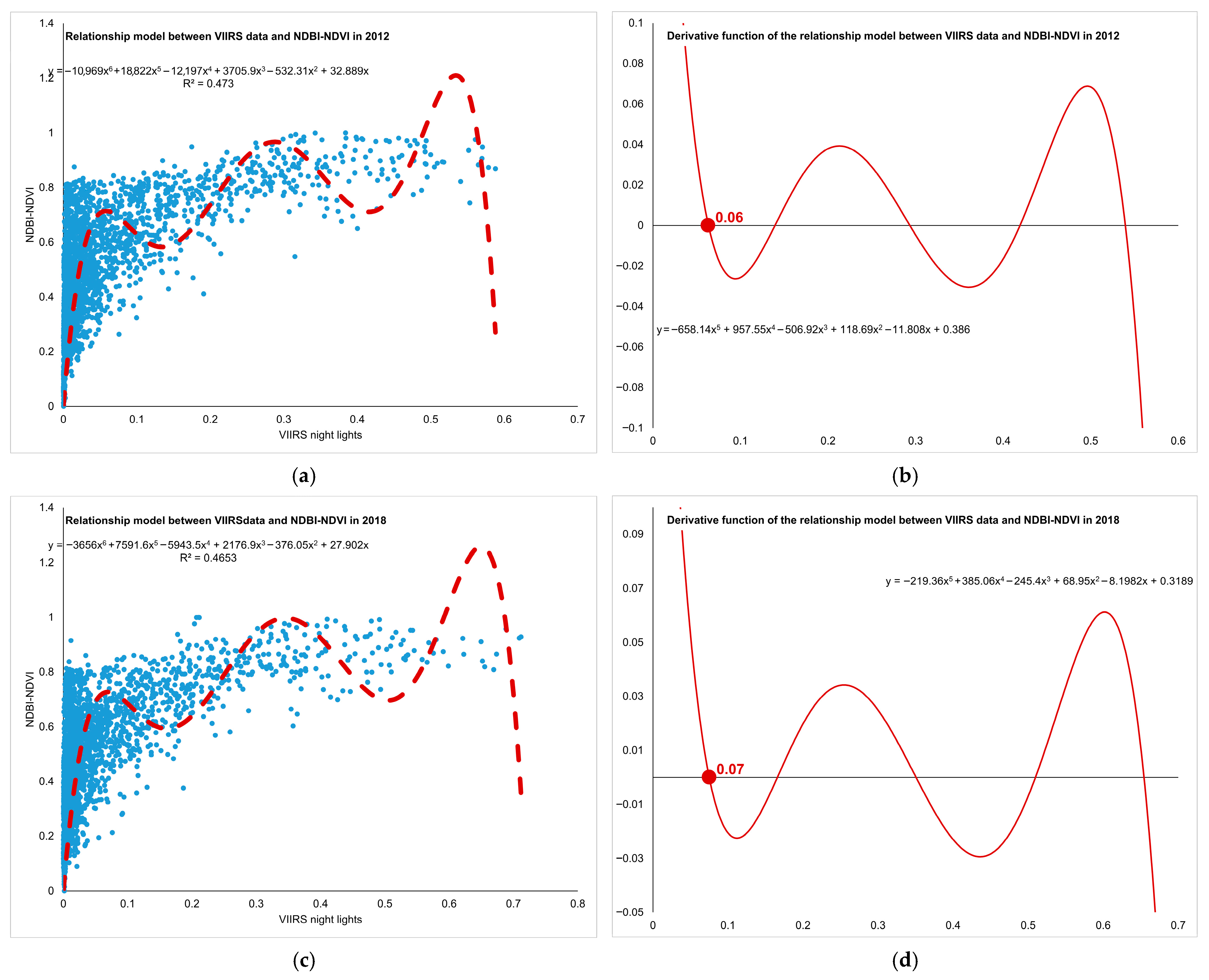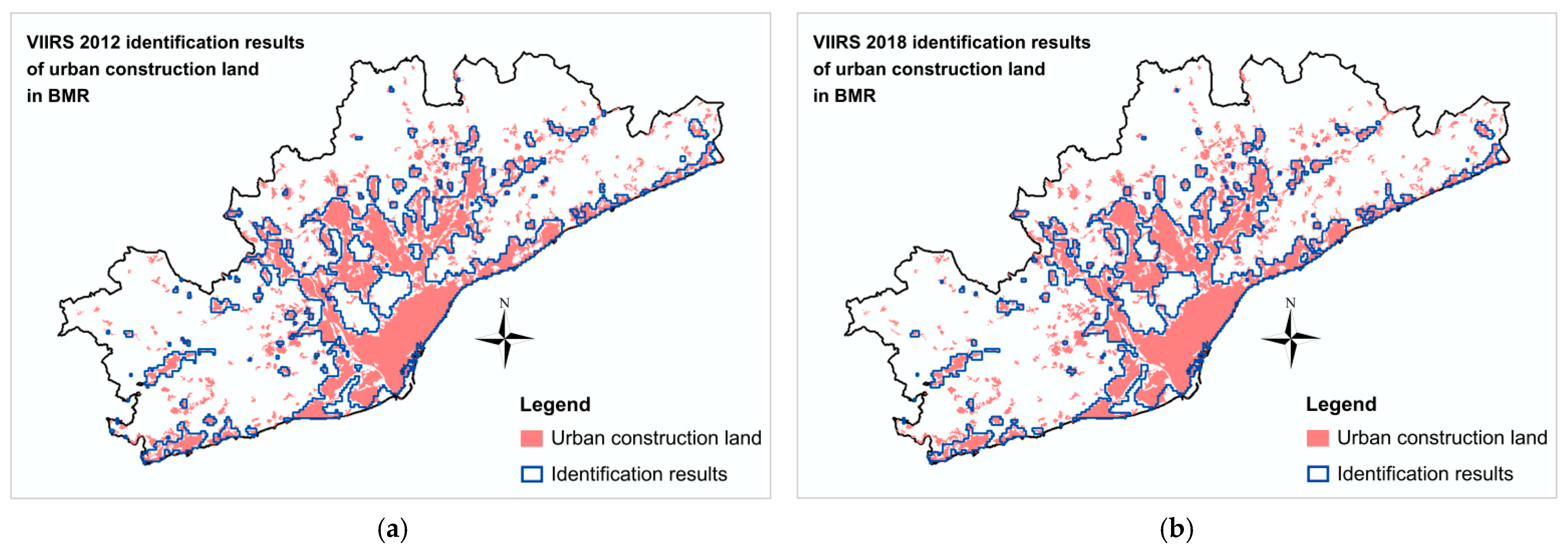1. Introduction
Urbanization is one of the most prominent spatial transformation processes of the 21st century, reshaping landscapes, ecosystems, and socioeconomic systems around the world [
1]. The rapid expansion of urban areas poses pressing challenges for sustainable development, infrastructure planning, and environmental management. In this context, remote sensing and GIS technologies have significantly enhanced the accuracy and efficiency of urban change detection and analysis of underlying driving forces [
2,
3]. For instance, in Ajmer, India, Jat et al. employed Landsat and LISS-III data to extract built-up areas from 1977 to 2002, revealing that urban expansion (160.8%) significantly outpaced population growth (50.1%) [
4]. Similarly, Masek et al. demonstrated the utility of NDVI and spatial texture constraints in delineating urban areas in Washington, D.C. [
5]. In Shiraz, Iran, Mahdi et al. found that urban vegetation declined markedly despite overall urban growth, highlighting the spatial asynchrony between greenness and built-up expansion [
6]. At global and regional scales, natural, climatic, demographic, and economic factors have all been identified as key drivers of urban expansion [
7,
8,
9,
10].
In recent years, an increasing number of scholars have employed nighttime light (NTL) data as a significant instrument for monitoring urbanization dynamics and spatial structure evolution [
11]. Compared to traditional land cover data, NTL data offer higher temporal continuity, enabling consistent tracking of urban growth trends. Moreover, the brightness of nighttime lights correlates strongly with human socioeconomic activity, making NTL a valuable proxy for measuring urban development intensity [
12,
13,
14,
15]. These datasets facilitate cross-regional and global urban studies by providing standardized and comparable measurements, particularly useful in capturing urban fringe expansion and monitoring the evolution of suburban or satellite cities [
16,
17].
The application of NTL data to urban studies dates back to Croft’s pioneering work in 1978, which first demonstrated the feasibility of using DMSP/OLS data to identify urban areas [
18]. Since then, significant advances have been made. Sutton et al. defined urban extents based on brightness thresholds, and used these to estimate built-up areas and assess global population distributions [
19]. Arellano et al. further integrated empirical and model-based methods to delineate 34 global metropolitan regions and classify suburban versus rural areas [
20,
21]. More recently, Zhao Min et al. combined DMSP/OLS and NPP/VIIRS datasets to extract global urbanized areas from 1992 to 2020 through a clustering-based thresholding approach [
22].
However, challenges remain. DMSP/OLS data suffer from low spatial resolution and light blooming effects, often resulting in overestimation of urban extents, especially in high-density regions [
23,
24,
25,
26,
27,
28]. While VIIRS and Black Marble datasets provide improved resolution and stability, threshold-based methods still require regional adaptation and calibration to avoid misclassification due to geographic and socioeconomic variability [
29]. Although the method proposed by Arellano et al. demonstrates high applicability in the major metropolitan areas, their results are derived from a single nighttime light data source for boundary extraction, lacking horizontal comparisons across different datasets. In addition, the technique does not incorporate correlation analyses between environmental factors and nighttime light data, which to some extent limits its applicability. These limitations highlight the need for more robust, data-integrated approaches to accurately delineate urban boundaries.
To address these gaps, this study proposes a novel methodology that integrates NTL data with spectral indices to delineate urban boundaries in the Barcelona Metropolitan Region (BMR). Specifically, multivariate regression models are used to identify key environmental and spectral variables—particularly NDVI and NDBI—that interact significantly with NTL brightness and urban form. Based on these findings, classification models are developed for three NTL datasets—DMSP/OLS, Black Marble, and VIIRS—to extract urban boundaries across scales. The results are evaluated and compared to assess performance and suitability under different spatial resolutions.
By systematically exploring the spatial heterogeneity and driving mechanisms of urbanized areas in the BMR, this study offers new insights into urban morphology detection using multi-source remote sensing data. The proposed approach not only improves the accuracy of urban boundary extraction but also contributes to urban planning, land use monitoring, and comparative urban studies in Europe and beyond.
3. Results
3.1. Analysis of the Correlation Factors Between Urbanized Areas in the BMR and Nighttime Light Brightness Distribution
To evaluate and analyze the factors influencing the spatial arrangement of urbanized areas in the BMR from 2006 to 2018, it was first necessary to extract urban land within the BMR based on land cover classifications provided by the CLC [
51]. To facilitate the distinction between urban land, built-up areas, and other non-urbanized regions, the original 11 land cover types were grouped into five main categories (
Table 3).
To further reveal the spatial patterns and evolutionary characteristics of urbanization in the BMR, we analyzed the changes in urban land and built-up land and produced detailed maps (
Figure 3) to illustrate the dynamic changes in urbanized areas.
Maps of urban land and built-up land changes can more intuitively and accurately reveal the evolutionary characteristics of urbanized areas in the Barcelona Metropolitan Region (BMR). To facilitate the observation of land gains and losses, the boundaries of urban land were magnified twofold when producing the map series using ArcGIS 10.8, thereby enhancing the readability of spatial distribution patterns (
Figure 3). Spatially, urban land in the BMR exhibits a fragmented pattern, distributed throughout most of the metropolitan area. Large urban concentrations are observed in Barcelona city and its northern parts, whereas the northernmost and western areas of the BMR show sparse urban land, mainly consisting of small, isolated urban patches. The land use intensity in Barcelona city is relatively high, with urban space almost fully occupied, except for a few undeveloped areas in the northern and southern parts. From the perspective of urban expansion, significant growth of urban land is observed within the BMA and surrounding areas, particularly in the northern and central BMR, where some scattered urban patches show expansion trends, while only a few patches expand in the western region. Simultaneously, some areas exhibit a reduction in urban land, mainly in the northeastern and northwestern BMR and in BMA regions outside Barcelona city. Overall, urban land in Barcelona city remained largely saturated and showed no significant change over the 12-year study period.
Compared with the fragmented distribution of urban land, built-up land enhances the connectivity between urban patches, optimizing the overall urban system structure. Spatially, the distribution pattern of built-up land is similar to that of urban land but fills more gaps, rendering the urban form more continuous. Built-up land almost completely covers Barcelona city and extends toward the southwestern and northeastern peripheries. Within the BMA, built-up land occupies more than half of the area, reflecting the further progression of urbanization. The expansion of built-up land is also concentrated in the northeastern BMR and both within and outside the BMA, with a few patches expanding in the western BMR, while small reductions are observed in the northwestern BMR and northeastern BMA. Built-up land in Barcelona city remained largely unchanged throughout the study period.
3.1.1. Analysis of the Correlation Factors of the Distribution of Urbanized Areas in the BMR
By constructing OLS interaction models with multiple explanatory variables, the relationship between various factors and the distribution of urban and built-up land in the BMR was analyzed [
52], helping identify significant variables. Based on a review of related studies, 15 natural and human factors were selected as explanatory variables [
38,
39,
40,
41,
42]. The study area was partitioned into 2985 grids, each measuring 1 km per side, with the proportion of urban and built-up land within each grid treated as the dependent variable. The explanatory variables comprised longitude, latitude, distance to the coast, elevation, slope, NDVI, precipitation, daytime and nighttime LST, LST difference, calibrated DMSP and VIIRS nighttime light intensity, NDBI, road network length, population, and GDP. Six OLS models were constructed using data from 2006, 2012, and 2018, with results in
Table 4 and
Table 5.
The analysis revealed that NDVI (−) is most strongly related to urbanized land distribution, particularly influencing built-up areas, while NDBI (+) is also significantly associated with urban land patterns. Together, these variables explain over 80% of the variation in urban land distribution in Barcelona and over 90% of changes in a broader urbanized space.
Additionally, the annual precipitation, as a natural factor, also has an intrinsic connection with the spatial distribution of urbanized areas; however, its underlying mechanism remains unclear. The model results indicate that the relationship between the two is positive in some cases but negative in others. Previous studies have suggested that precipitation may indirectly influence the spatial distribution of urban areas by affecting vegetation cover, soil moisture, and land use types [
53,
54]. Therefore, we included it as a potential explanatory variable in the initial model to examine its contribution. The day-night temperature difference (−) and nighttime LST (−) are also significantly linked to built-up land, while population (+) plays a key role in urbanized area distribution. The mechanism by which surface temperature influences urban heat islands (UHIs) is primarily reflected in their impact on the surrounding environment. Temperature differences between urban areas and other regions not only represent an important indicator of the spatial distribution of urbanization but also influence residential choices, land use patterns, and the direction of urban expansion [
55,
56]. Daytime LST was omitted from the optimal model because of its collinearity with the day–night LST difference.
3.1.2. Analysis of Influencing Factors on the Distribution of Nighttime Light Brightness in BMR
To identify key factors influencing the distribution of urbanized areas and nighttime light intensity in the BMR, and to establish an optimal light intensity threshold for delineating urban spatial boundaries, this study used the independent variables from previous analysis. Three OLS regression models were constructed using nighttime light intensity distributions from three different years as the dependent variable, with results presented in
Table 6.
The findings indicate that, similar to the models for urban and built-up land, NDVI (−) and NDBI (+) are the two most significant variables affecting nighttime light intensity. NDVI has a stronger impact than NDBI, and together, they explain approximately 80% of the spatial distribution of light intensity. Precipitation (with an unclear mechanism), nighttime land surface temperature (+), and diurnal temperature range (+) also play significant roles. Combined with NDVI and NDBI, these factors explain over 95% of the spatial distribution of nighttime light intensity in Barcelona.
Given the correlation between these variables and urbanized area distribution, NDVI and NDBI are core factors linking urban spatial patterns with nighttime light distribution, though other factors also contribute. Despite the strong potential relationship between precipitation, urbanized areas, and light intensity, precipitation’s complex interactions with other variables led to its exclusion from the optimal threshold model for urbanized area delineation [
57]. Additionally, due to its weaker correlation with the dependent variables, land surface temperature was used to validate the final delineation based on light intensity. The Pearson coefficients between all the above variables can be found in
Appendix C (
Table A2,
Table A3 and
Table A4).
Based on the above analysis, we found that NDVI (−) and NDBI (+) exhibit the most significant interactive relationships with both the distribution of urbanized areas and the intensity of nighttime lights. Therefore, we intend to develop correlation models integrating these two key factors with nighttime light data to extract the boundary characteristics of urbanized areas. It is important to note that this study does not consider nighttime light as an independent determinant, but rather emphasizes its coupled relationship with NDVI and NDBI. While the regression results show that nighttime light has a limited direct explanatory effect on urbanized areas, we found that its interaction with NDVI and NDBI can more effectively capture the continuity and boundary characteristics of urbanized areas spatially. Therefore, in this study, nighttime light serves as a supplementary factor, enhancing the rationality and stability of boundary delineation through its combination with NDVI and NDBI. This logic was supported by subsequent validation results, which showed good consistency between the resulting boundaries and the spatial patterns of population distribution and GDP, further demonstrating the effectiveness of the model approach.
3.2. The Results of Extracting the Urbanization Areas in the BMR Using Night-Time Light
3.2.1. Construction of the Night-Time Light Distribution Change Model
Based on the analysis, this study selects NDVI (−) and NDBI (+) as auxiliary variables and constructs a model with night-time light intensity to determine the optimal threshold for extracting the BMR urbanization boundaries. To improve data comparability, the study eliminates the effects of varying light data value ranges from the three datasets: DMSP, Black Marble, and VIIRS.
To achieve this objective, the study normalizes the DMSP and Black Marble data and standardizes the NDBI-NDVI values to minimize scale differences [
46,
47,
48]. For VIIRS data, a logarithmic LN transformation is applied to enhance light intensity differentiation and improve data applicability [
58]. Using the 2012 data as an example,
Figure 4 compares the spatial resolutions of BMR night-time light across the three data sources and shows the effect of the LN transformation on VIIRS data. The DMSP data has the lowest spatial resolution, while VIIRS has the highest. The transformed VIIRS data better highlights faint light intensity in dark areas, improving urbanization area identification accuracy.
Then, for analyzing the light value range in the relationship equation, we construct a regression model with the processed NDBI–NDVI as the dependent variable (y) and light intensity as the independent variable (x). Using the 2012 data as an example,
Figure 5 shows the scatter distribution of the two variables and their fitting curve. The results indicate that the relationship between them follows the characteristics of a quadratic polynomial function. Therefore, the key points for determining the urbanization area boundary can be identified through the extremum and the axis of symmetry of the derivative function. The extremum points and the axis of symmetry of the derivative functions for all experimental model equations are summarized in
Table 7, and the fitting equations and derivatives can be found in
Appendix D (
Table A5). Since we used the 2010 urbanization area boundary of the BMR, defined using night-time light data by Arellano et al. in previous work, as a reference, the 2010 data was also modeled and analyzed.
3.2.2. Results of Urbanized Area Boundary Extraction
In 2017 and the following year, Arellano et al. used two different resolution night light datasets, Black Marble and DMSP, along with regression modeling and geographic information analysis techniques, to extract and validate urbanized area boundaries globally, particularly in the BMR. Their studies [
20,
21] provided valuable reference results, especially the 2010 BMR urbanized area boundaries. However, due to the variable brightness value range of VIIRS data, its complexity in calculating precise values, and its high sensitivity to light, challenges remain in identifying urbanized areas [
59,
60,
61]. This study aims to explore the feasibility of using VIIRS data for urbanized area boundary extraction by applying a logarithmic transformation and combining it with NDBI and NDVI modeling.
The DMSP data contains observations from 2010, while VIIRS and Black Marble data have been available since 2012. In Arellano’s study, the 2012 Black Marble light data were used to infer the 2010 BMR urbanized area. Black Marble, optimized from VIIRS data with adjustments to the value range, has a spatial resolution similar to that of VIIRS. Thus, this study uses the Black Marble delineation results from previous research as the basis for extracting urbanized area boundaries from the 2012 Black Marble and VIIRS data.
This study identified and compared seven key light values from the three datasets. The results show that the urbanized area contours corresponding to the extremum points of DMSP and Black Marble, as well as the symmetric points of VIIRS in the NDBI-NDVI and night light fitting models for the BMR, closely match the reference results (
Figure 6).
Figure 6 presents a comparison of the BMR urbanized area boundaries extracted in this study with the reference boundaries. To further quantify the matching degree between the two, a logistic regression model was constructed with the reference boundaries as the dependent variable and the extracted results as the independent variable (
Table 8). Detailed information on the logistic regression model can be found in
Appendix E (
Table A6 and
Table A7).
The analysis shows that the extracted urbanized areas closely match the reference boundaries. The DMSP-based results achieved the highest overlap, with a correct recognition rate of 98.8% and overall accuracy above 99%. Black Marble also reached nearly 98% accuracy. Although VIIRS yielded slightly lower accuracy, it still explained over 90% of the urban areas defined by Black Marble. These results confirm the high accuracy and feasibility of the proposed method for delineating BMR urbanized boundaries. Finally, using this method, urbanized area boundaries from 2006 to 2018 were extracted with DMSP and VIIRS data (
Figure 7). Since Black Marble is not an independent data source but a derivative of VIIRS, it has certain limitations in spatial resolution. In this study, the two results obtained using data-based delimitation were very similar. In addition, both VIIRS data and DMSP data are original data, which makes horizontal comparison easier. Therefore, in the subsequent analyses, we retained the original VIIRS data, which has slightly higher resolution.
3.2.3. Extraction of Precise Urbanized Area Boundaries Using VIIRS
As shown in
Figure 6 and
Figure 7, whether referencing or delineating the urbanized area boundaries of the BMR, the results derived from DMSP data are significantly broader than those from the other two datasets.
Table 9 presents the corresponding urbanized area sizes from
Figure 6, revealing that the DMSP-derived boundaries cover approximately 800 km
2 more than those identified by Black Marble and VIIRS. This discrepancy is primarily due to the lower spatial resolution of DMSP, whereas VIIRS and Black Marble provide higher precision in detecting urban extents.
Additionally, all nighttime light sensors, including DMSP, are subject to varying degrees of light spillover. Consequently, these sensors tend to overestimate urban areas by capturing not only urban and built-up land but also adjacent urban fringes and suburban zones affected by light radiation. These peripheral areas, though less densely built, are economically active and integrated into the functional urban system of the BMR, forming part of the broader urbanized region [
20,
21,
23,
24,
25,
26,
27,
28].
In contrast, the finer spatial resolution of VIIRS data offers the potential for more accurate delineation of urban and built-up land boundaries. Therefore, this study further explores the extraction of construction land boundaries using the proposed modeling approach, based on VIIRS data.
This study first normalizes the raw values of VIIRS and NDBI-NDVI, and fits them using a polynomial regression model. After multiple fitting tests, we found that the first extremum point of the 6th-degree polynomial function between the two variables provides a relatively accurate identification of the main urban and construction area contours of BMR. We tested multiple fitting methods and polynomials of different orders. The results showed that the sixth-order polynomial outperformed other models in terms of goodness of fit and residual distribution, and could better capture the characteristics of the relationship between nighttime lights and NDBI–NDVI.
Figure 8 shows the regression model and its derivative functions based on the 2012 and 2018 data. The analysis results indicate that the first extremum points of the 6th-degree polynomial functions for these two years correspond to nighttime light values of 0.06 and 0.07, respectively. Furthermore,
Figure 9 visually demonstrates the built-up area contours extracted using this light threshold, which match highly with the CLC statistical data.
Table 10 shows the results of the logistic regression model built with CLC construction land data as the dependent variable and VIIRS identification results as the explanatory variable. More information about the model can be found in
Appendix F (
Table A8 and
Table A9). The results indicate a high consistency between the city and construction land identified by VIIRS and the CLC data. The 2012 model achieved a correct identification rate of 73.8% and an overall classification accuracy of 87.6%, while the 2018 model had a correct identification rate of approximately 70% and an overall classification accuracy of 86.8%. The model results also validate the effectiveness of using this method to extract precise urban and construction land areas with VIIRS data.
3.3. Verification and Analysis of Urbanized Area Boundary Extraction Results
In the previous experiments, although the accuracy and effectiveness of the BMR urbanized area extraction results using nighttime light data were assessed from the perspective of regional matching precision, a comprehensive analysis and evaluation of the recognition results are still needed. This evaluation should be based on three important factors from the urban system: population distribution, economic activity intensity, and surface temperature, which this study has found to be significantly correlated with the urbanized areas. This will ensure that the method proposed in this study is reliable and stable.
Table 11 presents the evaluation results of the BMR urbanized area (UA) and built-up land (CL) extraction based on nighttime light data, comparing them with the reference contours across several metrics, including the proportion of the population within the urbanized area relative to the total BMR population, the ratio of average surface temperature in the urbanized area to the average surface temperature of BMR, and the contribution rate to the total GDP of the metropolitan area. The results indicate that these evaluation metrics closely match the reference values and remain stable within a certain range. However, it should be noted, as described in the methodology, that there are currently no spatialized GDP datasets available for Barcelona. The GDP data used in this study were estimated based on existing data and therefore have substantial limitations in accuracy. Consequently, GDP can only serve as an auxiliary reference for validation and should not be regarded as a key criterion.
Regarding the population proportion, the urbanized area within the DMSP reference range accounts for 97% of the total BMR population, and the result based on DMSP extraction is close to this value. The population proportion within the Black Marble and VIIRS reference ranges is approximately 89%, with the experimental results ranging from 87.16% to about 89%, indicating minor and stable errors. For the built-up land area based on CLC statistics, the population within the range accounts for 79.5% of the total BMR population, and the population proportion within the built-up area extracted using VIIRS deviates by no more than 2% from the CLC statistics.
Owing to the urban heat island effect, the surface temperatures in urban areas is typically higher than in suburban and rural areas [
62]. Therefore, this study calculated the ratio of the average surface temperature in the urbanized area to the average surface temperature of BMR to assess its rationality. The results show that the ratio for the DMSP reference range is 1.05, while the extracted urbanized areas have a temperature ratio ranging from 1.04 to 1.07. The ratio for the Black Marble reference range is 1.07, and the temperature ratio for the extracted urbanized area ranges from 1.06 to 1.09, maintaining a high consistency. Additionally, the surface temperature ratio for the CLC statistics on built-up land is between 1.07 and 1.11, while the VIIRS extracted built-up land ratio is slightly higher, between 1.1 and 1.13. Although there is some deviation, it remains within a reasonable range.
In terms of economic activity, we evaluated the contribution of urbanized areas extracted using different methods to the total GDP of BMR. The results indicate that the urbanized land extracted from DMSP contributes 92.53–96.9% of the GDP, while the GDP contribution from the Black Marble and VIIRS urbanized areas ranges from 83.7% to 85.94%. Additionally, the GDP contribution of CLC stated built-up land is between 50% and 52.82%, while the contribution from the VIIRS extracted built-up land is about 60%. The GDP values show some error as they are derived from the spatial distribution estimated under limited conditions in this study, but the overall trend remains stable, and they can be used as a reference for assessing the accuracy of urbanized area delineation based on nighttime light data.
In summary, analyzing from the perspectives of population distribution, surface temperature, and economic activity, the method proposed in this study for extracting the BMR urbanized area and built-up land using multi-source nighttime light data is close to the reference evaluation results and remains stable within a reasonable range. This result further validates the effectiveness and stability of the proposed method, providing robust support for urban spatial identification research based on nighttime light data.
4. Discussion
This study assessed the correlations between natural and anthropogenic factors and the spatial distribution of urban areas and nighttime light intensity. NDVI and NDBI were identified as the most relevant variables for supporting urban space identification using nighttime light data. Precipitation and land surface temperature also showed important associations. Our previous research used a spatial triangular model to analyze the interaction between precipitation and NDVI, which may help interpret the complex precipitation relationships observed in this study [
34]. Although surface temperature was used here to validate urban boundaries, its interactions with NDVI, NDBI, and light data require further investigation and will be prioritized in future work.
We used the 2010 BMR urbanized area from Arellano et al. as a reference and proposed a method that identifies urban boundaries by determining optimal brightness thresholds for three nighttime light datasets. Compared to earlier approaches, this method improves extraction accuracy and stability and avoids the limitations of using a single threshold across different periods and urbanization stages [
20,
21]. By integrating NDBI and NDVI, two environmental factors, with nighttime light data, the method’s applicability to regions with varying conditions has been greatly enhanced. Specifically, this method does not rely on land cover products specific to a given region but instead captures urbanization characteristics through a coupled spectral and nighttime light model, providing a technical pathway reference for less developed countries lacking fine-scale land cover statistics. Nighttime light data and MODIS imagery are globally available, thus offering a feasible alternative for such regions. Based on this, we further delineated built-up areas using higher-resolution VIIRS data. Despite mitigation efforts, light overglow still caused slight overestimation [
25,
26,
27], which remains a limitation and future research priority.
In
Figure 5, it can be seen that the R
2 values of the fitted curves based on the scatter distribution between nighttime lights and environmental variables are not high. However, the focus of this study is on capturing the overall variation trends between variables rather than precisely predicting individual data points. Although there is considerable variation between points, the shape of the fitted curves aligns with the overall scatter distribution, effectively reflecting the macro-level trends in the data. In the context of urban boundary analysis, identifying large-scale spatial patterns is more critical than accurately predicting individual values. It should be noted that R
2 primarily reflects the degree of fit of data points to the model, rather than the consistency of trends, and for some valid models, R
2 may be low [
63]. For nighttime light data, which are susceptible to various sources of noise, the scatter may exhibit high dispersion, yet it still provides valuable insights into the overall relationship between nighttime lights and influencing factors [
12,
64,
65]. Therefore, these fitted curves effectively represent the potential relationship between nighttime light intensity and NDBI–NDVI indicators in the Barcelona Metropolitan Region.
In addition, multi-source nighttime light data have a significant impact on the accuracy of the final urban boundary products. Different data sources vary in spatial resolution, temporal coverage, and noise characteristics [
66]. Low-resolution DMSP-OLS data may cause blurred boundaries and omission of small urban plaques, whereas high-resolution VIIRS data can capture finer spatial details [
67,
68]. Temporal discrepancies between datasets may introduce bias in long-term urbanization trend analyses; however, data calibration and integration can partly mitigate this issue [
69,
70], for example, by using DMSP-like data calibrated with 2018 VIIRS data. Beneficially, the integration of different nighttime light datasets can help reduce uncertainties caused by factors such as weather conditions and sensor errors, thereby improving the stability of urban boundary delineation. Moreover, combining environmental variables such as NDVI and NDBI can provide supplementary information when nighttime light data alone are insufficient to identify urbanized areas [
71,
72].
While NDVI and NDBI constitute the core environmental variables for delineating urban boundaries in this study, other environmental factors also provide valuable supplementary insights. Land surface temperature reflects the spatial manifestation of the urban heat island effect, and its transitional patterns at the urban fringe can help to characterize ambiguous boundary zones [
73,
74]. Likewise, slope and distance to the sea capture the influence of topography and geographic setting, which may partly account for boundary shifts in areas with complex terrain [
75,
76]. Precipitation, although shaped largely by land cover patterns, can also indirectly indicate the differentiation between urbanized and non-urbanized land [
77,
78]. In contrast to the direct explanatory role of NDVI and NDBI, these additional factors mainly serve as moderating and validating elements, strengthening the robustness and transferability of the boundary delineation framework across different regions and contexts. Nevertheless, their contributions to boundary identification remain relatively indirect and therefore fall outside the primary focus of this paper. As a promising direction for future research, a more systematic and in-depth exploration of these environmental variables, as well as their interactions with core indices, could provide further refinement and extension of the methodological framework for urban boundary delineation.
Due to data availability, some spatial datasets were estimated. GDP distribution was calculated using LandScan population data combined with total population and per capita GDP from the Catalan Statistical Institute, which limits its accuracy. Thus, GDP was used only for supplementary validation. Climate monitoring through remote sensing also faces difficulties, such as coarse precipitation resolution and inconsistent land surface temperature data [
79]. Improving the precision of GDP and climate datasets will be essential for future analyses.
Finally, the contours of the urbanized areas extracted in this study often differ from administrative unit boundaries. Administrative boundaries constitute the legal spaces within which local and higher tier governments implement policies and coordinate governance, whereas boundaries identified using nighttime light and remote sensing data primarily reflect the actual spatial structure of urbanized areas and the distribution of human activities. The BMR consists of 164 municipalities and several towns, and its administrative boundaries are crucial for the provision of public services, resource allocation, and policy implementation. However, this study focuses on delineating urbanized areas from a macro perspective based on remote sensing and spatial indicators, and therefore does not provide a systematic analysis of the discrepancies between administrative boundaries and the extracted boundaries. This limitation highlights the potential misalignment between urban spatial governance and actual urban development, and points to a promising direction for future research to compare and integrate the two types of boundaries.
5. Conclusions
Using multivariate regression models, this study assessed the relationships between various influencing factors and urban land, construction land, and nighttime light data in the Barcelona Metropolitan Region (BMR) from 2006 to 2018. NDVI (−) and NDBI (+) emerged as the most critical variables, strongly correlated with both urbanized areas and light intensity, thereby effectively linking them. Based on these variables, models integrating multi-source nighttime light data were constructed to determine optimal brightness thresholds for delineating urban boundaries. Results demonstrate that incorporating the NDBI-NDVI significantly enhances the accuracy of urban area extraction, particularly for built-up land using VIIRS data.
Principally, NDVI (−) and NDBI (+) serve as key variables linking the distribution of urbanized areas in the BMR with nighttime light intensity.
Among all variables, NDVI has the greatest influence on the distribution of urbanized areas, built-up land, and nighttime light intensity. The second most significant factor is NDBI.
The model also indicates that two climatic factors, land surface temperature and precipitation, show a noticeable correlation with the dependent variables. However, their explanatory power is significantly lower than that of the two most prominent covariates. Moreover, the effect of precipitation is highly complex [
34], and thus it was not included as an optimal explanatory variable in this study.
Based on these two key factors, we developed mathematical models using three different nighttime light datasets to determine the optimal light intensity thresholds for identifying urban spaces and verified their accuracy and stability.
Figure 5 illustrates significant differences in the resolution and precision of the three nighttime light datasets, which also creates opportunities for identifying more refined built-up area boundaries.
By applying normalization or the natural logarithm (Ln) transformation, we successfully established regression models between nighttime light intensity and NDBI-NDVI. The extrema and symmetry axis of the fitted function help determine the large-scale urbanized area of the BMR, which is influenced by urban radiation and coalesces with urban areas through economic activities, infrastructure development, and functional planning [
26,
27,
28].
Additionally, higher-resolution nighttime light data correspond to more precise identification of urbanized areas.
The first extremum of the fitted function in the regression model between normalized VIIRS and NDBI-NDVI serves as a threshold for extracting more detailed urban and built-up area boundaries.
We comprehensively evaluated the identified urban spaces from multiple perspectives, including spatial matching accuracy, population distribution, land surface temperature, and economic activity intensity. The results confirm the high feasibility, effectiveness, and stability of the proposed method.
